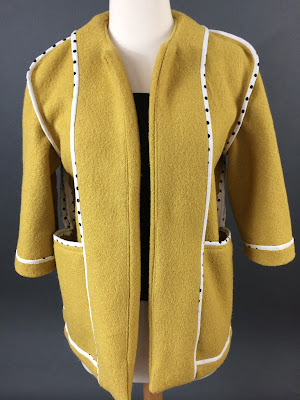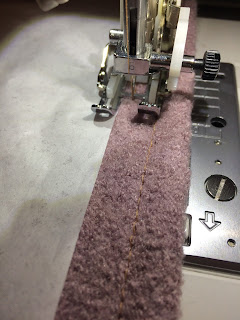Last month, my husband ticked off the one and only thing on my Christmas wishlist--a woven leather bag in the most gorgeous dusty rose shade. It inspired me to sew a matching coat or jacket so I browsed online for the perfect fabric match.
I found the perfect match in this solid boiled wool from Mood Fabrics. It is a blend of 60% viscose/40% wool in Deauville Mauve.
I searched for coat/jacket patterns that had boiled wool as part of the recommended fabrics and settled for Simplicity 1540.
I was attracted to the unique collar options. I thought to myself since winter usually finds me wearing my outerwear most of the time, why not create a stylish winter wardrobe?
I made view D which features an oversized pleated collar.
Since I already posted a review of the pattern
here at the Pattern Review website, this blog post will be about the challenges I faced sewing with boiled wool and how I tackled them.
Preparation
Dry cleaning or hand washing were the recommended method of cleaning the fabric as noted on the Mood website. I have pretreated wool fabrics before by using steam or the dryer but opted not to pretreat this time as I was planning to have the finished garment dry cleaned.
Pattern Layout
My fabric had some nubby texture and a barely discernible nap. There was a definite right and wrong side. I marked the wrong side and the direction of the nap to make sure all pattern pieces were laid out correctly.
Sewing tools
*polyester thread
*universal size 70 needle
*longer stitch length (3) on Juki F600 and even longer for topstitching
*walking foot
Tackling Fabric Thickness
The resulting seams created by sewing this medium weight fabric were quite thick. I could not use hot iron to press them open because I did not want to distort the fabric or flatten the nubby texture so I had to rely on finger pressing assisted by my handy dandy pressing tool.
To make sure the seams remained open after pressing, I topstitched the seams down.
View of the topstitching from the wrong side.
I trimmed down the seams after topstitching.
The pattern I used involved a lot of pleating and darts on the oversized collar. To help lessen the bulk, I sliced the darts open to be able to press them open.
View of the darts on the wrong side of the collar.
I also used Clover clips instead of pins to hold the layers together prior to sewing.
To work around the bulk when sewing the pockets down, I just trimmed off the allowance around the pocket edges and did away with folding in as the fabric did not ravel.
Stabilizing seams
As when sewing knits, I stabilized certain areas of the jacket with seam binding. The fabric had a minimal amount of stretch and it wouldn't hurt to be proactive.
Seam binding along the shoulder seams.
Along back waist seam.
Sewing Process
I discovered while sewing through the thick texture wool that some of the fibers tended to snag on my walking foot. Strangely enough, it only happened to the left side of the walking foot. This was easily solved by putting a piece of tissue paper over the fabric while sewing.
And as with quilting thick fabrics, I reduced the pressure on my presser foot by one notch.
Interfacing
Going by the information provided in "Fabric Sewing Guide" by Claire Shaeffer, I skipped the application of interfacing on the front facing because my fabric was already thick and had enough structure.
After all is said and done, I would say sewing with a fabric that did not ravel was quite enjoyable. I was tempted to add a lining to the pattern just because I was accustomed to a lined outerwear but decided to embrace the design intended for a nonraveling fabric.
Jacket Closure
One last thing I'd like to share is the button treatment. The jacket only needed a simple closure in the form of snaps but I am not a fan of snaps. To dress it up a bit, I applied a couture technique to the snaps and wrapped it in a silk fabric in the same shade as the coat. It was easy to make, pretty much like making a fabric yoyo.
Here are more pictures of the finished jacket.




















































